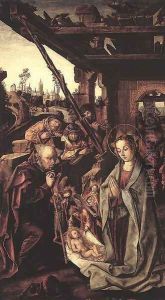Rodrigo de, the Younger Osona Paintings
Rodrigo de Osona the Younger was a prominent Spanish painter active during the late 15th and early 16th centuries. Born in Valencia, Spain, around 1465, he was part of a notable family of artists, with his father, Rodrigo de Osona the Elder, being a well-regarded painter of the Valencian school. This familial background provided the younger Rodrigo with a rich artistic heritage and a solid foundation in the arts from an early age. The Osona family workshop was a hub of creativity and innovation, contributing significantly to the Valencian Renaissance.
Rodrigo de Osona the Younger's work is characterized by its devotion to detail, vibrant color palette, and incorporation of both religious and secular themes. His style represents a blend of Gothic and Renaissance elements, demonstrating both the influence of his father's Gothic tendencies and the newer, proportion-focused techniques of the Renaissance. This stylistic amalgamation made his work particularly appealing, as it bridged the transition between the medieval and modern artistic sensibilities.
Throughout his career, Rodrigo the Younger focused primarily on religious commissions, producing altarpieces, panel paintings, and frescoes for churches and cathedrals in and around Valencia. His works often featured scenes from the life of Christ, the Virgin Mary, and the saints, imbued with emotional depth and spiritual fervor. Notably, his ability to convey complex theological themes through accessible and visually captivating imagery made his work highly sought after.
Despite the prestige he enjoyed in his lifetime, Rodrigo de Osona the Younger's legacy has been somewhat overshadowed by contemporary artists of the Spanish Renaissance, such as El Greco and Alonso Berruguete. Nonetheless, his contributions to the development of Valencian art are significant. His paintings are preserved in various museums and churches, serving as enduring testaments to his skill and artistic vision.
Rodrigo de Osona the Younger's exact date of death is uncertain, but it is believed he died around 1518. His passing marked the end of an important chapter in the history of Valencian painting, but his influence persisted through the works of artists who followed in the tradition he helped to shape. His legacy is not only in his surviving works but also in his contribution to the evolution of Spanish Renaissance art, blending traditional and innovative elements to create a unique and enduring artistic language.
